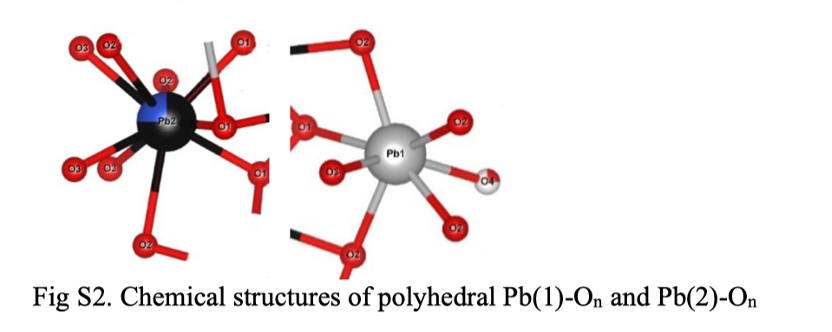室温常压超导体 LK99论文机翻
注:以下全文为翻译软件机翻,如有涉及专利权等法律问题,请联系作者删除。
正文
我们有史以来第一次成功地合成了在环境压力下工作的室温超导体(T c ≥ 400 K,127 o C),并具有改进的铅-磷灰石(LK-99)结构。 用临界温度(Tc)、零电阻率、临界电流(Ic)、临界磁场(Hc)和迈斯纳效应证明了LK-99的超导性。 LK-99的超导性源于轻微体积收缩(0.48%)的微小结构失真,而不是温度和压力等外部因素。 收缩是由Pb(2)-磷酸盐绝缘网络中Pb2+(2)离子的Cu 2+取代引起的,并产生应力。 它同时将圆柱柱传输到Pb(1),导致圆柱柱界面失真,从而在界面中产生超导量子阱(SQW)。 热容结果表明,新模型适用于解释LK-99的超导性。 LK-99的独特结构允许在界面中保持微小的扭曲结构,这是LK-99在室温和环境压力下保持和表现出超导性的最重要因素。
For the first time in the world, we succeeded in synthesizing the room-temperature superconductor (T c ≥ 400 K, 127 o C) working at ambient pressure with a modified lead-apatite (LK-99) structure. The superconductivity of LK-99 is proved with the Critical temperature (Tc ), Zero-resistivity, Critical current (Ic ), Critical magnetic field (Hc ), and the Meissner effect. The superconductivity of LK-99 originates from minute structural distortion by a slight volume shrinkage (0.48 %), not by external factors such as temperature and pressure. The shrinkage is caused by Cu 2+ substitution of Pb2+ (2) ions in the insulating network of Pb(2)-phosphate and it generates the stress. It concurrently transfers to Pb(1) of the cylindrical column resulting in distortion of the cylindrical column interface, which creates superconducting quantum wells (SQWs) in the interface. The heat capacity results indicated that the new model is suitable for explaining the superconductivity of LK-99. The unique structure of LK-99 that allows the minute distorted structure to be maintained in the interfaces is the most important factor that LK-99 maintains and exhibits superconductivity at room temperatures and ambient pressure.
介绍
自发现第一个超导体(1)以来,通过其实验清晰度或/和理论视角(4-8),世界各地已经进行了许多寻找新室温超导体的努力(2,3)。 最近开发含硫化氢(9)和钇超氢化物(10)的室温超导体的成功受到全世界的极大关注,这是与高频氢声子模式的强电子-声子耦合理论所预期的(11,12)。 然而,由于压力极高,很难在日常生活中将其应用于实际应用设备,并且正在做出更多努力来克服高压问题(13)。
我们有史以来第一次报告了用化学方法合成室温和环境压力超导体以解决温度和压力问题的成功情况。 我们命名了第一个室温和环境压力超导体LK-99。 通过临界温度(Tc)、零电阻率、临界电流(Ic)、临界磁场(Hc)和迈斯纳效应(14、15)证明了LK-99的超导性。 收集并详细分析了几个数据,以找出LK-99超导性的难题:X射线衍射(XRD)、X射线光电子光谱(XPS)、电子顺磁共振光谱(EPR)、热容和超导量子干扰器件(SQUID)数据。 从今以后,我们将报告和讨论我们的新发现,包括与LK-99超导率相关的超导量子阱。
Since the discovery of the first superconductor(1), many efforts to search for new room-temperature superconductors have been carried out worldwide(2, 3) through their experimental clarity or/and theoretical perspectives(4-8). The recent success of developing room-temperature superconductors with hydrogen sulfide(9) and yttrium super-hydride(10) has great attention worldwide, which is expected by strong electron-phonon coupling theory with high-frequency hydrogen phonon modes(11, 12). However, it is difficult to apply them to actual application devices in daily life because of the tremendously high pressure, and more efforts are being made to overcome the high-pressure problem(13).
For the first time in the world, we report the success in synthesizing a room-temperature and ambient-pressure superconductor with a chemical approach to solve the temperature and pressure problem. We named the first room temperature and ambient pressure superconductor LK-99. The superconductivity of LK-99 proved with the Critical temperature (Tc ), Zero-resistivity, Critical current (Ic ), Critical magnetic field (Hc ), and Meissner effect(14, 15). Several data were collected and analyzed in detail to figure out the puzzle of superconductivity of LK-99: X-ray diffraction (XRD), X-ray photoelectron spectroscopy (XPS), Electron Paramagnetic Resonance Spectroscopy (EPR), Heat Capacity, and Superconducting quantum interference device (SQUID) data. Henceforth in this paper, we will report and discuss our new findings including superconducting quantum wells associated with the superconductivity of LK-99.
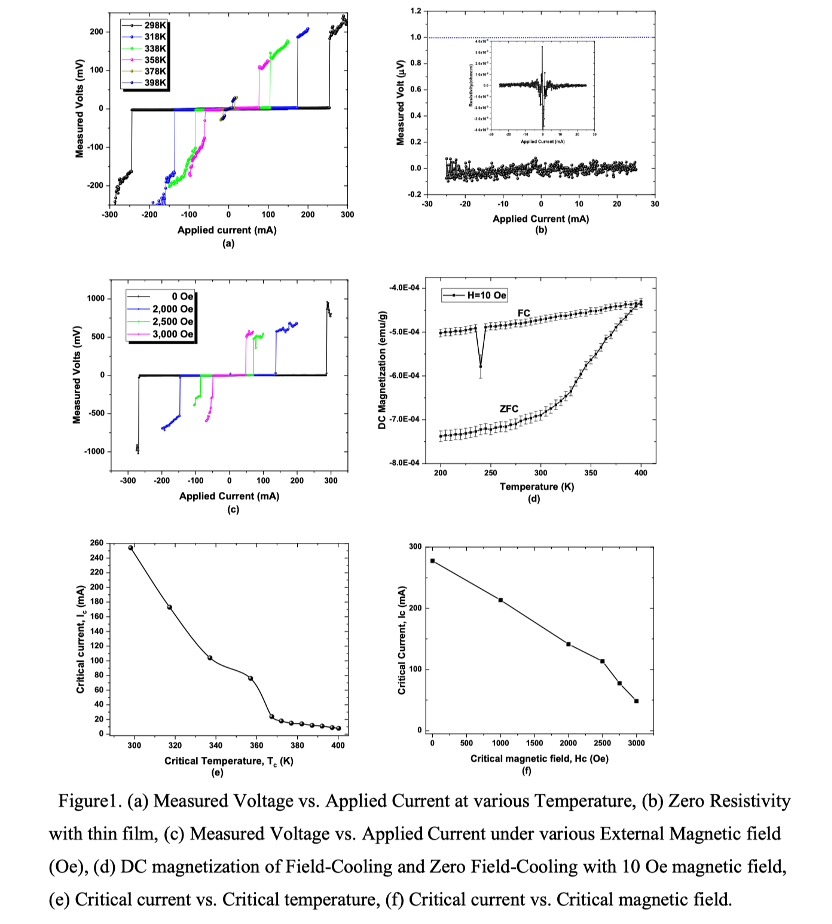
图1.(a)测量电压与 在不同温度下施加电流,(b)薄膜零电阻率,(c)测量电压与 各种外部磁场(Oe)下的应用电流,(d)10 Oe磁场的场冷却和零场冷却的直流磁化,(e)临界电流与 临界温度,(f)临界电流与 临界磁场。
图1(a)显示了不同温度(298 K~398K)下的测量电压与施加电流,图1(a)的测量是在10-3 Torr的真空中,直流(DC)极性变化3的真空中每增加20K温度。 在各种散装样品中,测量了10-6至10-9Ω·cm的特异性电阻。 此外,通过热蒸汽沉积工艺在精密玻璃板上制备了LK-99薄膜(UNIVAC,韩国)。 图1(b)显示了LK-99薄膜的零电阻率,它满足了国际标准(16,17)作为新型超导体的零电阻率。 根据国际电工委员会的标准(16),超导率有两个等效标准(17):1μV/cm或0.1μV/cm的电场标准和10-11Ω·cm的电阻率标准。 如图1(b)所示,在施加电流增加和减少期间,测量的电压在0.1μV/cm范围内得到。 此外,电阻率按10-10~10-11Ω·cm的顺序计算。 随着晶界的减少,薄膜的残余电阻降低(18)。 图1(c)显示了施加电流的外部磁场(H)依赖性。 即使高达400K,零场冷却和10 Oe的现场冷却的直流磁化值在图1(d)中仍然为负值。 这些结果表明,超导相在10 Oe下仍然存在,最高可达400K。 此外,即使在图1(e)和(f)中400K和3000 Oe或更多时,临界电流值也不是零(7 mA)。 因此,我们判断LK-99的临界温度超过400K。 此外,由于LK-99具有图2所示的多晶形态,散装样品的不均匀电阻率可以解释为晶间边界、粒际涡流、多晶超导相的自由涡流(18-20)。 还观察到超导体-正常金属-超导体(21、22)或粒际耦合超导体(23)阻尼连接的约瑟夫森样现象(补充材料中的图S1(a))以及粒内或粒内网络的热电效应(补充材料中的图S1(b))。
Figure 1(a) shows the measured voltage vs. applied current at various temperatures (298 K ~ 398K), the measurement for Figure 1(a) was performed with direct current (DC) polarity change by each 20 K increment of temperature in the vacuum of 10 -3 Torr. In various bulk samples, specific resistance was measured in the range of 10 -6 to 10 -9 Ω·cm. Also, a thin film of LK-99 was fabricated on the precision glass plate by a thermal vapor deposition process (UNIVAC, Korea). Figure 1(b) shows the Zero-resistivity of the thin film of LK-99, which satisfied the zero-resistivity of international standards(16, 17) as a new superconductor. According to the International Electrotechnical Commission standards(16), there are two equivalent criteria(17) for superconductivity: the electric field criterion with 1 µV/cm or 0.1 µV/cm and resistivity criterion with 10 -11 Ω·cm. As shown in Figure 1(b), the measured voltage was obtained in the range of 0.1 µV/cm during the applied current increasing and decreasing. Also, the resistivity was calculated in the order of 10 -10 ~ 10 -11 Ω·cm. As the grain boundary is decreased, the residual resistance of the thin film decreased(18). Figure1(c) shows the external magnetic field (H) dependence of applied current. Even up to 400 K, the DC magnetization value of Zero field cooling and Field cooling with 10 Oe was still negative in Figure 1(d). These results indicate that the superconducting phase still exists under 10 Oe up to 400 K. Additionally, the critical current value was not yet zero (7 mA) even at 400 K and 3000 Oe or more in Figure 1(e) and (f). Therefore, we judge that the critical temperature of LK-99 is over 400 K. Moreover, since LK-99 has a polycrystalline morphology shown in Figure 2, the non-uniform resistivity of the bulk samples can be explained as inter-grain boundaries, intergranular vortex flow, free vortex flow(18-20) of polycrystalline superconducting phase. The Josephson-like phenomenon (Figure S1(a) in supplementary materials) for the under-damped junction of superconductor-normal metal-superconductor(21, 22) or Intergrain coupled superconductors(23) and the thermoelectric effect(24-26) of the inter- or intra-grain network(Figure S1(b) in supplementary materials) were also observed.
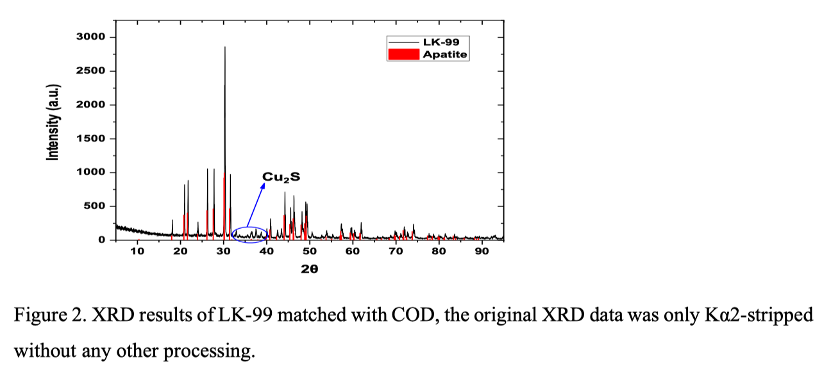
图2。 LK-99的XRD结果与COD匹配,原始XRD数据仅被Kα2条纹,无需任何其他处理。
图2显示了LK-99与QualX2.0软件(27)匹配的结果,并通过使用VESTA软件(28)的模拟数据证明,该软件使用晶体学开放数据库(COD)执行搜索匹配操作(27)。 它表明LK-99是多晶的。 主要峰值与铅-磷灰石(AP)结构非常匹配,也很少显示Cu2 S杂质。 原始铅-脂肪矿的晶体系统是六边形的(P63 /m,176),细胞参数为a=9.865 Å和c=7.431 Å。 然而,与参数为a=9.843 Å和c=7.428 Å的铅磷灰石相比,LK-99略有收缩。 LK-99的体积减少为0.48%。 人类早就知道,物质的性质源于其结构。 然而,到目前为止,超导性和材料结构变化之间的相关性几乎没有得到适当澄清。 事实上,到目前为止发现的影响超导体超导产生的两个主要因素是温度和压力(29、30)。 温度和压力都会影响它的体积。 在低温或高压下体积下降所产生的应力似乎会导致微小的应变或失真。 虽然很难观察到超导材料的微小结构变化,但这种结构变化似乎带来了超导性。
Figure 2 shows the results of LK-99 matched with the QualX2.0 software(27) and proved by simulated data using VESTA software(28), which uses Crystallography Open Database (COD) to perform the search-match operation(27). It shows that LK-99 is polycrystalline. The main peaks were well matched with the lead-apatite (AP) structure, and few Cu2 S impurities also shown. The crystal system of the original lead-apatite is hexagonal (P63 /m, 176) with the cell parameters a=9.865 Å and c=7.431 Å . However, LK-99 shows a slight shrinkage compared to the LeadApatite with parameters of a=9.843 Å and c=7.428 Å . The volume reduction of LK-99 is 0.48 %.
Humankind has long learned that the properties of matter stem from its structure. However, so far, the correlation between superconductivity and the structural change of material has hardly been properly clarified. In fact, the two main factors affecting the generation of superconductivity of superconductors discovered so far are temperature and pressure(29, 30). And both temperature and pressure affect its volume. It seems that the stress generated by the decrease in volume under the low temperature or high pressure causes a minute strain or distortion. Although it is difficult to observe the minute structural changes in superconducting materials, this structural change seems to bring the superconductivity of it.
显示外部因素(压力和温度)和内部因素(掺氧)造成的超导性的代表性例子是基于CuO的超导材料。 根据掺氧含量,CuO的结构从四边形结构转变为正交结构。 此外,在高压条件下观察到较高的Tc(29)。 在基于CuO的超导体中,可以认为c轴以及a轴和b轴变化量不一致产生的应力影响中间CuO层,导致结构失真和超导性,因为c轴的变化似乎对温度和压力的变化最敏感。 其他例子是我们认为由精细物理应力引起的失真或应变引起的超导性外观。 当绝缘子顶部的FeSe单层堆叠时,最高T c达到65 K(31),甚至高达109 K(32)。 然而,随着图层堆栈的增加(33-35),T c降至10K。 在Bi2 Sr2 Cu2 O8+δ上的CuO单层薄膜中,Zhong等人确定了两个不同且空间分离的间隙:U样间隙和V样间隙(36)。 2019年,Choi等人证明了3D应变对板条系统(37)的T c的影响,BaFe2 As 2系统在2013年也显示了应变诱导的超导性(38)。 2008年,Gozar等人报告了金属和绝缘氧化铜之间的高温界面超导性(39)。 层越薄,应力诱导效应越大,应变越大,这似乎是超导过渡温度越高。 因此,我们认为,温度和压力引起的应力会带来微小的结构失真和应变,从而产生超导的电子状态。
Representative examples showing the superconductivity due to the external factors (pressure and temperature) and the internal factors (oxygen doping) are CuO-based superconducting materials. The structure of CuO changes from the tetragonal structure to the orthogonal structure depending on the oxygen doping contents. In addition, the higher T c is observed under the high pressure condition(29). In the CuO based superconductors, it may be thought that the stress generated by the inconsistency of the amount of change in the c-axis and a and b-axis affects the intermediate CuO layer, causing structural distortion, and superconductivity because the changes in the c-axis seems to be the most sensitive to changes in temperature and pressure. And other examples are what we think of as the appearance of superconductivity caused by distortion or strain caused by fine physical stress. When the FeSe monolayer on the top of the insulator is stacked, the highest T c achieves up to 65 K(31) and even up to 109 K(32). However, the T c lowers to 10 K as layer stacks increases (33-35). In the case of CuO monolayer films on Bi2 Sr2 Cu2 O8+δ , Zhong et al. identified two distinct and spatially separated gaps: U-like gap and V-like gap(36). In 2019, Choi et al. proved the effect of 3D strain for T c in the cuprate system(37), and BaFe2 As 2 system also showed strain-induced superconductivity(38) in 2013. In 2008, Gozar et al. reported hightemperature interface superconductivity between metallic and insulating copper oxides(39). The thinner the layer, the greater the stress-inducing effect, the greater the strain, which seems to be the higher the superconducting transition temperature. Therefore, we argue that the stress caused by temperature and pressure brings a minute structural distortion and strain, which create an electronic state for superconductivity.
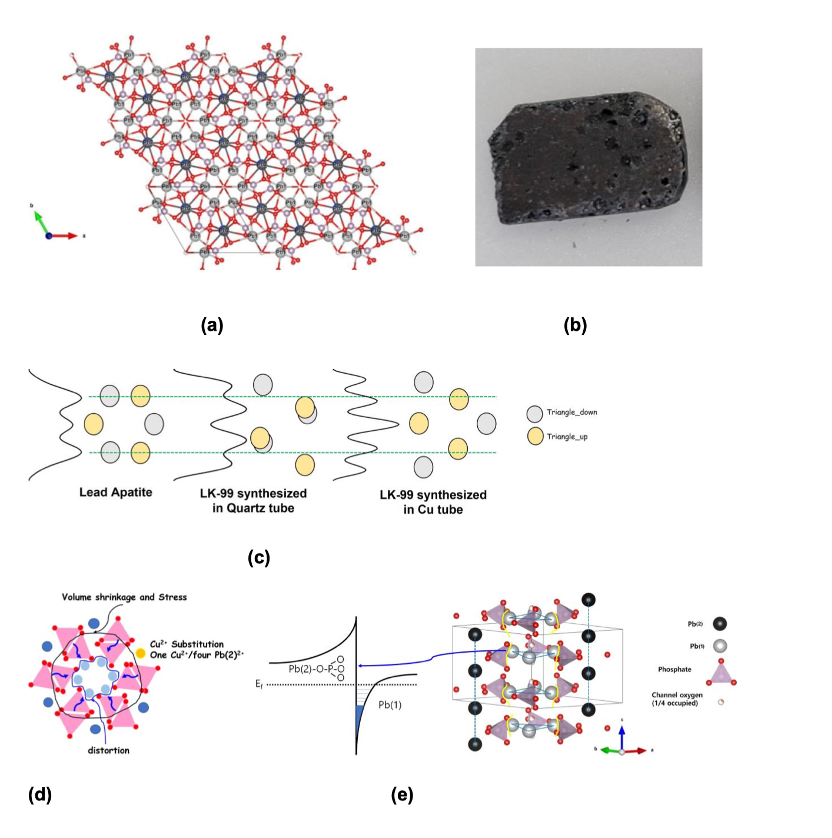

图3.(a)VESTA软件生产的铅磷灰石和LK-99的c轴顶视图(28),(b)合成的LK-99,(c)磷灰石铅圆柱界面Pb(1)和用不同管(Cu和石英管)合成的LK-99的计算电子密度图,(d)VESTA软件生产的圆柱应力界面的顶视图,(e)圆柱柱的侧视图(28)和预测的超导量子阱,(f)LK-99从3.43 K到295 K的EPR信号,(g)电流电压测量后LK-99的EPR信号。
LK-99是灰黑色,如图3(b)所示。 它是与典型超导体颜色相同的超导体。 铅-脂肪矿(40),Pb10(PO4)6 O系统,是一种象牙色粉末和绝缘体。 LK-99具有图3(a)所示的三维网络结构和由绝缘四面体PO 4网络结构包围的圆柱形柱。 间隔为6.541Å的圆柱由不对称多面体六个Pb(1)-O n分量组成,由两个形状相反的三角形组成,如图3(e)中圆柱的侧视图所示。 多面体四Pb(2)是LK-99绝缘PO 4网络结构的组件。 LK-99的改性铅磷灰石预计为Pb10- x Cux(PO4)6 O,x=0.9~1.0,其中四个Pb(2)离子中的一个大约已被铅-脂肪(41)多面体Pb(2)位点的Cu(II)离子取代。 在LK-99中,铜的比例是根据XPS的原子百分比数据确定的,并由具有热容结果和化学式Pb10-x Cux(PO4)6 O,x=0.9~1.0的Debye热容模型确认。 它与之前公布的研究结果(41)非常一致。 这种在LK-99中替换Cu 2+离子导致体积减少0.48%,因为Cu 2+离子(87 pm)小于Pb 2+离子(133 pm)。 应力发生在网络部分,然后影响超导性的外观。
LK-99 is a gray-black color, as shown in Figure 3(b). It is the superconductor with the same color as typical superconductors. The system of lead-apatite(40), Pb10 (PO4 )6 O, is an ivory-colored powder and an insulator. The LK-99 has a three-dimensional network structure shown in figure 3(a) and a cylindrical column surrounded by an insulating tetrahedral PO 4 network structure. And the cylindrical columns arranged at intervals of 6.541 Å are composed of asymmetric polyhedral six Pb(1)-O n components consisting of two oppositely shaped triangles as shown in the side-view of the cylindrical column in Figure 3(e). The polyhedral four Pb(2) are components of insulating PO 4 network structures of LK-99. The modified lead-apatite of LK-99 is expected to be Pb10- x Cux (PO4 )6 O, x=0.9~1.0, in which one of the four Pb(2) ions approximately has been replaced by Cu(II) ion at the polyhedral Pb(2) sites of the lead-apatite(41). In LK-99, the ratio of copper was determined based on the atomic % data of XPS and confirmed by the Debye heat capacity model with heat capacity result and chemical formula Pb10-x Cux (PO4 )6 O, x=0.9~1.0. And it is well consistent with previous published research result(41). This replacement of Cu 2+ ions in LK-99 resulted in a volume reduction of 0.48 % because Cu 2+ ions (87 pm) are smaller than Pb 2+ ions (133 pm). The stress was occurred in the network portion and then affected the appearance of superconductivity.
通过对XRD和XPS数据进行更精确的分析,它揭示了体积减少的压力最终受到的影响。 为了确定Pb(1)位置的变化,通过计算结构因子的傅里叶变换,沿一个晶体轴进行了一维电子密度计算(42)。 根据XRD数据的(00l)反射强度,使用以下方程计算了沿z方向ρ(c)电子密度。
As a result of more precise analysis of XRD and XPS data, it reveals where the stress from volume reduction was finally affected. For the purpose of determining the variation of Pb(1) positions, One-dimensional electron density calculation(42) along one crystallographic axis via the Fourier transform of the calculated structure factor was used. The electron density was calculated along the z-direction, ρ(c), based on the (00l) reflection intensities of XRD data using the following equation.

其中l、F(00l)、c和z分别是(00l)衍射峰的阶、结构因子、c轴的单位细胞参数和沿z轴的原子坐标。 由于LK-99具有六边形结构,根据图2中XRD数据的(00l)和(h00)反射强度,将上述方程应用于沿z方向(c轴)和x方向(a轴)以及ρ(c)和ρ(a)的Pb(1)电子密度计算。 因此,通过在图3(c)中向内或向外替换Cu 2+,构成圆柱柱的Pb(1)在a轴平面上的位置略有偏移。 在圆柱Pb(1)的重复三角形结构中,一层Pb(1)之间的距离从原始3.03340Å增加到2.61815Å,下一层的距离增加到5.23476Å。 然而,LK-99的Pb(1)三角形层之间穿过c轴的距离(3.7140Å)与铅-脂肪岩(3.7153Å)几乎保持不变。 根据XPS数据的分析结果,Pb(2)和磷的结合能(B.E.)保持不变。 虽然2p 3/2和2p1/2之间的四面体磷分裂值非常小,从0.68 eV增加到0.69 eV,所有氧B.E.分别增加了0.21 eV、0.33 eV、0.56 eV和0.89 eV。 此外,Pb(1)的B.E.值略有下降0.03 eV。 从上述结果中可以看出,体积减少是由铜2+离子的替换引起的,体积减少引起的应力导致Pb(1)的位置变化和Pb(1)附近氧原子之间的结合能变化。 图3(f)显示了LK-99的EPR信号。 它与异质结量子阱相同,如Si/SiGe(43),干燥状态的天然DNA(44)和掺杂Mg2+的α-Fe2 O3(45)。 EPR信号被解释为量子阱二维电子气体(2-DEG)的回旋加速器共振信号,这也证实了LK-99的Pb(1)和磷酸盐界面中量子阱的形成。 此外,如图3(f)所示,替换的Cu 2+离子出现在3000 Oe的EPR信号中。 据报道,GaAs/AlGaAs(46)和DNA(47)的2-DEG系统的超导性为0.3K和1K。 具有界面结构的超导体,如2-DEG系统的异质结,如LaAlO3 /SrTiO3(48-50),已被证明具有超导性。 因此,经证实,超导量子阱(SQW)是通过结构畸变和应变在磷(1)和磷酸盐氧之间产生的。 预测的SQW如图3(e)所示。 LK-99的超导性与SQW密切相关。 2002年,Koji等人已经报告了如图3(f)所示的类似的EPR信号和RuSr2 GdCu2 O8系统(51)的超导性。 然而,他们没有将EPR信号解释为SQW,并将其与超导性的外观联系起来。
Where l, F(00l), c and z are the order of the (00l) diffraction peak, the structure factor, the unit cell parameter of the c-axis, and the atomic coordinate along the z-axis, respectively. Since LK-99 has a hexagonal structure, the above equation was applied for the electron density calculation of Pb(1) along the z-direction (c-axis) and x-direction (a-axis), and ρ(c) and ρ(a), based on the (00l) and (h00) reflection intensities of XRD data in Figure 2. As the result, the position of Pb(1) constituting the cylindrical column is slightly shifted in the a-axis plane from the original position by the substitution of Cu 2+ inward or outward in Figure 3(c). In the repeated triangular structure of Pb(1) of the cylindrical column, the distance between Pb(1) in one layer is decreased to 2.61815 Å , and the next layer is increased to 5.23476 Å from the original distance of 3.03340 Å . However, the distance (3.7140Å ) through the c-axis between the triangular layers of Pb(1) of LK-99 remains almost unchanged from lead-apatite (3.7153Å ). According to the analyzed results of XPS data, the binding energies (B.E.) of Pb(2) and Phosphorus were unchanged. Although, the tetrahedral Phosphorus splitting value between 2p 3/2 and 2p1/2 very slightly increased from 0.68 eV to 0.69 eV, and all oxygens B.E. are quite a bit increased by 0.21 eV, 0.33 eV, 0.56 eV, 0.89 eV, respectively. Also, the B.E. value of Pb(1) is slightly decreased by 0.03 eV. From the results described above, it can be seen that the volume reduction was caused by the replacement of Cu 2+ ions, and the stress caused by the volume reduction caused the position change of Pb(1) and the binding energy change between oxygen atoms adjacent to Pb(1). Figure 3(f) shows the EPR signal of LK-99. It is the same as the heterojunction quantum well such as Si/SiGe(43), natural DNA(44) in a dry state, and α-Fe2 O3 (45) doped with Mg2+ . The EPR signals were interpreted as a cyclotron resonance signal of 2-dimensional electron gas (2-DEG) of quantum well, which also confirmed the creation of quantum wells in the interface between Pb(1) and Phosphate of LK-99. In addition, the substituted Cu 2+ ions were appeared at 3000 Oe in EPR signals as shown in Figure 3(f). The superconductivity with the 2-DEG system of GaAs/AlGaAs(46) and DNA(47) was reported at 0.3 K and 1 K. The superconductor having interface structure like a heterojunction of the 2-DEG system such as LaAlO3 /SrTiO3 (48-50) has been shown the superconductivity. Hence, it is confirmed that the superconducting quantum well (SQW) was generated between Pb(1) and Oxygens of Phosphate by structural distortion and strain. The predicted SQW was illustrated in Figure 3(e). The superconductivity of LK-99 is deeply related to SQW. In 2002, Koji et al. already reported the similar EPR signals as shown in Figure 3(f) and the superconductivity with RuSr2 GdCu2 O8 system(51). However, they did not interpret the EPR signals as SQW and to associate it with the appearance of superconductivity.
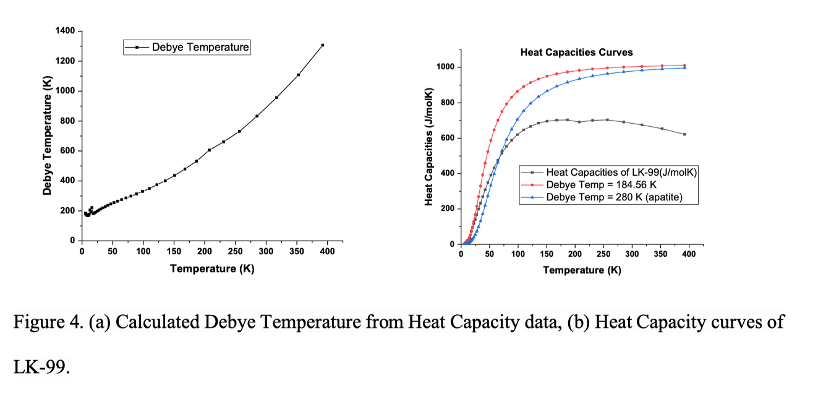
图4.(a)从热容数据计算的擦除温度,(b)LK-99的热容曲线。
使用物理性质测量系统(PPMS,DinaCool-9,Quantum Design,USA)测量LK-99的热容从5K到400K,并通过以下Debye热容方程,根据Pb10-x Cux(PO4)6 O公式(x=1)的热容数据计算了Debye温度;
The heat capacity of LK-99 was measured from 5 K to 400 K using Physical Property Measurement System (PPMS, DinaCool-9, Quantum Design, USA), and Debye temperature was calculated based on the heat capacity data using Pb10-x Cux (PO4 )6 O formula (x = 1) through the following Debye heat capacity equation;

其中C v是热容,r是每个分子的原子数量,N是分子数,k是玻尔兹曼常数。 图4显示,LK-99的德拜温度不断从大约184K变化到1300K。 因此,T c无法用电子声子预测模型计算。 蓝线曲线(德拜温度=280 K)是典型磷灰石的计算热容,因为典型磷灰石的德拜温度为280 K。 红线曲线是根据LK-99低温(5K)下的Debye温度(184.56 K)计算的热容结果。 在传统超导体的情况下,电子声子模型对此进行了相对很好的解释。 在电子声子模型中,预测T c的最有影响力的参数之一是德拜温度(52)。 LK-99的热容曲线(黑线曲线)不遵循Debye模型,因为正常振动模式受到LK-99网络部分Cu 2+离子替换的限制。 这一结果还证实了LK-99的结构因Cu 2+离子的替换而失真。 根据LK-99所示的EPR实验结果,超导性的表达可以用SQW的形成来解释。 还有一篇论文用量子阱模型(36)解释了超导性。 然而,他们没有显示像我们这样的EPR信号。 图3(d)是电流电压测量后在样品(LK-99)上测量的EPR信号。 与不施加电流的信号(图3(f))相比,总体信号强度下降,回旋加速器共振的信号强度在图3(g)中相对降低。 此外,对于基于CuO的超导体,大吸收EPR信号在非常低的温度和低于1000 Oe的外部磁场(53,54)下出现,我们还观察到YBCO和Bi2212。 1000 Oe外部磁场以下的信号可以解释为超导电子的信号(53,54)。
where C v is heat capacity, r is the number of atoms per molecule, N is the number of molecules, and k is the Boltzmann constant. Figure 4 shows that the Debye temperature of LK-99 is constantly changing from about 184 K to 1300 K. Thus, T c cannot be calculated with the electron-phonon prediction models. The blue line curve (Debye temperature = 280 K) is the calculated heat capacity of the typical apatite because the Debye temperature of the typical apatite is 280 K. The red line curve is the calculated heat capacity results based on Debye temperature (184.56 K) at a low temperature (5 K) of LK-99. In the case of conventional superconductors, it is relatively well explained by the electron-phonon model. And in the electron-phonon model, one of the most influential parameters of predicting T c is Debye temperature(52). The heat capacity curve (black line curve) of LK-99 does not follow the Debye models, since the normal vibrational mode is limited by Cu 2+ ions replacement in the network part of the LK-99. This result also confirms that LK-99 has a structure distorted by the substitution of Cu 2+ ions. In terms of the EPR experimental results shown in LK-99, the expression of superconductivity can be explained by the formation of SQWs. There is also a paper explaining superconductivity with the quantum well model(36). However, they did not show EPR signals like ours. Figure 3(d) is the EPR signal measured on the sample (LK-99) after Current-Voltage measurement. Compared to the signal in which no current is applied (Figure 3(f)), the overall signal intensities decreased, and the signal intensity of cyclotron resonance was relatively decreased in Figure 3(g). Additionally, in case of CuO based superconductors, the large absorption EPR signal appeared at a very low temperature and below 1000 Oe external magnetic field(53, 54), and we also observed with YBCO and Bi2212. The signal below 1000 Oe external magnetic field can be interpreted as a signal by superconducting electrons(53, 54).
Josephson在超导体之间安装了一个薄绝缘体,并发现了电流流过的隧道。 超导体之间发生了隧道(55)。 同样,如果电子通过在SQW之间隧道移动,电阻自然为零。 SQW之间的隧道可能是可能的,因为SQW预计将在LK-99中以3.7Å~6.5Å的间隔形成。 根据Kim的论文(52),他使用1250 K的Debye温度计算室温超导体,Ashcroft(56)在1968年提到了氢化物。 即使在这种情况下,他也认为电子-电子相互作用比电子-声子相互作用具有更高的温度超导性。 在LK-99系统中,施加的电流似乎通过隧道过程通过圆柱柱的相关SQW传输,并与所有SQW一起以三维连贯传输。 关于LK-99的额外实验结果和讨论将立即发表在下一篇论文中,包括一个有趣的可控悬浮现象以及磁性和超导共存、理论计算等。 LK-99对许多研究人员来说将是一种有吸引力的物质,可以解决与超导性相关的各种令人困惑的难题,如配对过程和与磁性共存等。
Josephson installed a thin insulator between superconductors and discovered tunneling through which current flows. Tunneling occurred between the superconductors(55). Likewise, if electrons are moved by tunneling between SQWs, the resistance will naturally be zero. Tunneling between SQWs is likely to be possible, as SQWs are expected to be formed at 3.7 Å ~ 6.5 Å intervals in LK-99. According to Kim’s paper(52), he used 1250 K Debye temperature for his calculation of room-temperature superconductor, which is mentioned for hydride in 1968 by Ashcroft(56). Even in that case, he argued that the electron-electron interaction contributes to the higher temperature superconductivity than the electron-phonon interaction. In LK-99 system, the applied current seems to be transported through the correlated SQWs of the cylindrical column via the tunneling process and coherently transported in 3-dimension with all SQWs together. The additional experimental results and discussions on LK-99 will be published immediately in the next paper, including an interesting controllable levitation phenomenon and the coexistence of magnetism and superconductivity, theoretical calculation, etc. LK-99 will be an attractive substance for many researchers that can solve various confusing puzzles such as the pairing process and coexistence with magnetism, etc., related to superconductivity.
因此,为什么LK-99在室温和环境压力下表现出超导性? 这是因为由于LK-99的结构唯一性,Pb(2) 2+离子的Cu 2+替换产生的应力没有缓解,同时适当地转移到圆柱的界面。 换句话说,LK-99圆柱界面中的Pb(1)原子占据了结构有限的空间。 这些原子完全受到铜2+离子产生的应力和应变的影响。 因此,在室温和环境压力下,可以通过适当的失真(57)在界面中产生SQW,而无需松弛。 从这个角度来看,在CuO和Fe基超导体系统中,温度和压力导致体积收缩引起的应力得到了缓解和消失,因为由于结构自由度,松弛过程不能受到限制。 因此,它们需要适当的温度或压力来限制结构自由度并实现SQW生成。 LK-99是研究室温超导难题非常有用的材料。 所有证据和解释都表明,LK-99是第一个室温和环境压力超导体。 LK-99具有多种应用的可能性,如磁铁、电机、电缆、悬浮系统、电源电缆、量子计算机量子比特、THz天线等。 我们相信,我们的新发展将是一个全新的历史事件,为人类开启一个新时代.
Consequently, why does LK-99 exhibit superconductivity at room temperature and ambient pressure? This is because the stress generated by the Cu 2+ replacement of Pb(2) 2+ ion was not relieved due to the structural uniqueness of LK-99 and at the same time was appropriately transferred to the interface of the cylindrical column. In other words, the Pb(1) atoms in the cylindrical column interface of LK-99 occupy a structurally limited space. These atoms are entirely affected by the stress and strain generated by Cu 2+ ions. Therefore, SQWs can be generated in the interface by an appropriate amount of distortion(57) at room temperature and ambient pressure without a relaxation. From this point of view, the stress due to volume contraction by temperature and pressure is relieved and disappeared in CuO- and Fe-based superconductor systems because the relaxation process cannot be limited due to the structural freedom. Therefore, they need an appropriate temperature or pressure to limit the structural freedom and to achieve the SQW generation. The LK-99 is a very useful material for the study of superconductivity puzzles at room temperature. All evidence and explanation lead that LK-99 is the first room-temperature and ambient-pressure superconductor. The LK-99 has many possibilities for various applications such as magnet, motor, cable, levitation train, power cable, qubit for a quantum computer, THz Antennas, etc. We believe that our new development will be a brand-new historical event that opens a new era for humankind.
补充材料
样品合成与制备
样品合成和制备 对于LK-99的样品合成,使用了一般固态反应。 Lanarkite和Cu3 P在带有杵的玛瑙砂浆中均匀混合,摩尔比为1:1。 将样品放入反应管中,在10-5 Torr的真空下密封,并在925°C下反应10小时。 反应后,可重现获得深灰色的锭,然后制成薄立方体的形状进行电测量。 在其他分析中,它被粉碎并用作粉末的形式。 用于上述固态反应的试剂是PbO(JUNSEI,GR)、PbSO 4(KANTO,GR),Cu(DAEJUNG,EP)和P(JUNSEI,EP)。
Sample Synthesis and Preparation
For the sample synthesis of the LK-99, the general solid-state reaction was used. Lanarkite and Cu3 P were uniformly mixed in a molar ratio of 1:1 in an agate mortar with a pestle. The sample was put into a reaction tube, sealed under the vacuum of 10 -5 Torr and reacted at 925°C for 10 hr. After the reaction, a dark gray ingot was obtained reproducibly and then made into the shape of thin cuboids for electrical measurements. For other analyses, it was pulverized and used as the form of powder. The reagents used for the above solid- state reaction was PbO (JUNSEI, GR), PbSO 4 (KANTO, GR), Cu (DAEJUNG, EP), and P (JUNSEI, EP).
1)lanarkite的制备,Pb2SO5
PbO和PbSO 4粉末在带有杵的玛瑙砂浆中均匀混合,摩尔比为1:1。 然后,在样品转移到氧化铝坩埚中后,它在725°C的炉子中反应24小时。 反应完成后,获得了白色样品。 它被砂浆粉碎了。
1) Preparation for lanarkite, Pb2 SO5
PbO and PbSO 4 powders were uniformly mixed in a molar ratio of 1:1 in an agate mortar with a pestle. And then, after the sample was transferred to an alumina crucible, it was reacted at 725 °C for 24 hour in a furnace. After completion of the reaction, white sample was obtained. It was pulverized with the mortar.
2)制备磷化铜,Cu3 P
在每个成分比例中混合了铜和磷粉。 样品被转移到石英管中。 管子在10-5 Torr的真空下密封,并在550°C的炉子中反应48小时。 从管子中取出后,获得并粉碎了深灰色的锭子。
2) Preparation for copper phosphide, Cu3 P
Cu and P powders were mixed in each composition ratio. And the sample was transferred in a quartz tube. The tube was sealed under the vacuum of 10 -5 Torr and reacted at 550 °C for 48 hour in a furnace. After taken out from the tube, a dark gray ingot was obtained and pulverized.
电气性能测量设置
4点探针测量使用4个四个pogo测试探头(YoungJinSa,Inc.,韩国)相互绝缘,并排列成一条相同距离(1.2毫米)的线。 Keithley 228A和Keithley 182分别用作电压/电流源和敏感数字电压表。 为了准确的温度控制和测量,我们开发并使用了带有隔热铝安装板和卤素灯的自设计的加热装置作为加热源。 使用LabView软件的自行开发软件也用于测量。 所有测量仪器都与GPIB接口设备相连。 使用Keithley 2000在样品表面使用FLUKE 80BKDMM K型热电偶探头进行了温度测量。
Set-up for electrical properties measurement
4-point probe measurement was performed with 4 four pogo test probes (YoungJinSa, Inc., Korea) insulated from each other and arrayed in one line with the same distance (1.2mm). The Keithley 228A and Keithley 182 were used as voltage/current source and sensitive digital voltmeter, respectively. For accurate temperature control and measurement, we developed and used the self-designed heating device with a thermally insulated aluminum mounting plate and halogen lamp, as a heating source. The Self-developed software, using LabView software, was also used for the measurement. All measuring instruments were linked with GPIB interface devices. Temperature measurement was carried out with Keithley 2000 with FLUKE 80BKDMM K-type thermocouple probe on the sample’s surface.
XRD数据的收集
在韩国大学绿色制造技术研究所绿色制造研究中心与Rigaku(日本SmartLab)收集的XRD数据XRD数据。
Collection of XRD data
XRD data collected with Rigaku (SmartLab, Japan) at Institute of Green Manufacturing Technology Green Manufacturing Research Center of Korea University.
用SQUID测量磁性(MPMS)
磁化测量使用直流模式进行,扫描长度为30毫米,每次测量扫描10次,扫描时间为10秒,使用超导量子干扰装置(韩国KAIST研究促进分析中心的MPMS3-Evercool)。 零场冷却在没有外部磁场的情况下从400K加工到200K,然后用10 Oe磁场将温度从200K提高到400K。 最后,样品在10 Oe磁场下从400K冷却到200K。 45.814毫克样本用于此测量。
Measurement of Magnetic Properties with SQUID (MPMS)
Magnetization measurement is performed with dc mode, 30 mm scan length, 10 scans per measurement, scan time 10s by using Superconducting Quantum Interference Device (SQUID) (MPMS3-Evercool of KAIST Analysis Center for Research Advancement, Korea). Zero fieldcooling is processed from 400 K to 200 K without external magnetic field and then the temperature is increased from 200 K to 400 K with 10 Oe magnetic field. Finally, the sample is cooling down from 400 K to 200 K with 10 Oe magnetic field. The 45.814 mg sample is used for this measurement.
电子顺磁共振光谱测量
EPR光谱使用JESFA200 ESR X波段光谱仪在3.45 K至295 K的温度范围内进行(日本Jeol)。 入射微波功率为0.9980 mW,接收器增加100和扫描时间(1分钟)。 调制磁场在100 KHz下为10 G,扫荡外部磁场为-100 ~ 9,900 Oe或0 Oe ~ 10,000 Oe。 LK-99样品设置在5毫米石英管中(Wilmad LabGlass,美国),在I-V测量之前,LK-99密封真空(5 x 10 -5 torr),在I-V测量后,LK-99样品没有密封真空。 然后将密封的石英管装入配备液氦低温器系统的气缸腔(美国高级研究系统)。
Measurement of Electron Paramagnetic Resonance Spectroscopy
EPR Spectroscopy is performed over the temperature range from 3.45 K to 295 K using a JESFA200 ESR X-band spectrometer (Jeol, Japan). The incident microwave power is 0.9980 mW,the receiver gains 100 and the sweep time (1 min). The modulated magnetic field is 10 G at 100 KHz and the swept external magnetic field is -100 ~ 9,900 Oe or 0 Oe ~ 10,000 Oe. The LK-99 sample is set in a 5 mm quartz tube (Wilmad LabGlass, USA), sealed vacuum (5 x 10 -5 torr) for LK-99 before I-V measurement, not sealed vacuum for LK-99 sample after I-V measurement. And then the sealed quartz tube was loaded into a cylinder cavity equipped with a liquid helium cryostat system (Advanced Research Systems, USA).
用PPMS测量热容量
在下一代半导体收敛技术研究所(DGIST,韩国)使用物理性质测量系统(PPMS)(DynaCool-9,量子设计,美国)收集了5K至400K和65.26毫克LK-99的热容量数据。 原始数据使用Cu2 S散装和纳米片的热容参考进行了校准,纳米片作为杂质包含在少量中。
Measurement of Heat Capacity by PPMS
The heat capacity data were collected from 5 K to 400 K with 65.26 mg of LK-99 using by Physical Property Measurement System (PPMS) (DynaCool-9, Quantum Design, USA) in Institute of Next-generation Semiconductor convergence Technology (DGIST, Korea). And the raw data was calibrated with heat capacity references of Cu2 S bulk and nanosheet, which is included in a small amount as an impurity.
铅-磷灰石和LK-99的X射线光电子光谱(XPS)研究
XPS数据收集自韩国大学绿色制造技术研究所绿色制造研究中心ULVAC-PHI(日本X-TOOL)。 Pb、P、O和Cu的XPS数据使用XPSPEAK 4.1软件进行解卷曲。 使用雪莉背景函数校正背景,并使用洛伦兹(80%)-高斯(20%)和函数进行拟合。
X-ray Photoelectron Spectroscopy (XPS) Study on the lead-apatite and LK-99
XPS data collected from ULVAC-PHI (X-TOOL, Japan), Institute of Green Manufacturing Technology Green Manufacturing Research Center of Korea University. The XPS data of the Pb, P, O and Cu are deconvoluted using XPSPEAK 4.1 software. The background is corrected using the Shirley background function and the Lorentzian (80%)-Gaussian (20%) sum function is used for fitting.
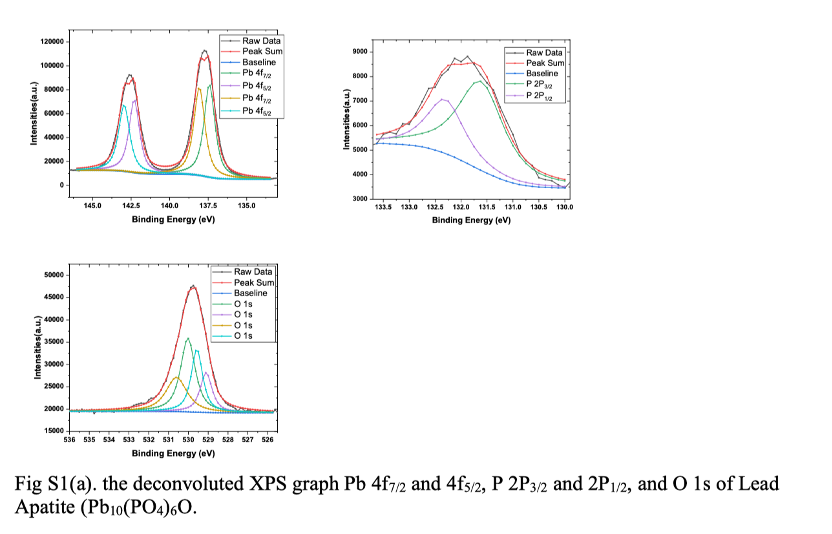
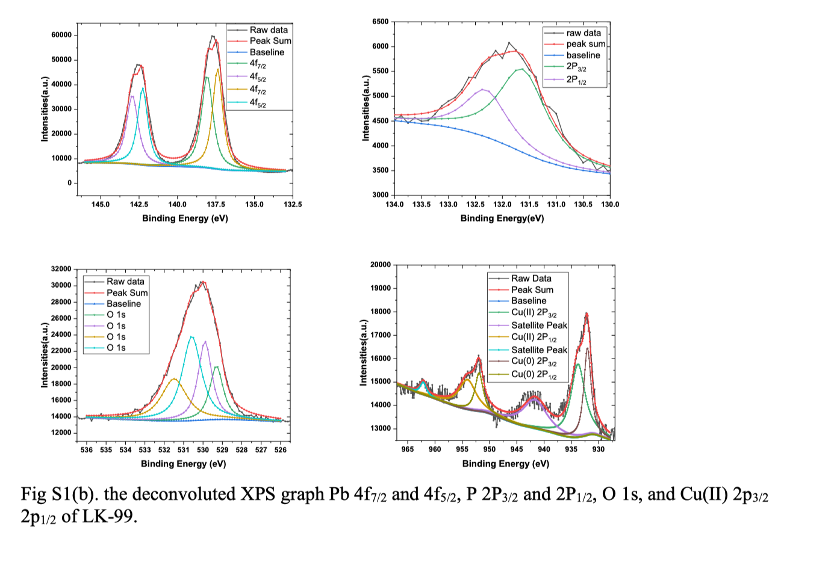
在Cu的XPS结果中,结合能(B.E.) 932.05 eV,951.91 eV来自Cu(0)原子,这是反应物Cu3 P的残基。只有933.78 eV,954.03 eV来自LK-99基质的替代Cu(II)离子,其余是Cu(II)离子的卫星峰。 原子取代量是使用相对原子灵敏度计算的。 结果约为Cu/Pb=0.9/10。
In the XPS results of Cu, Binding Energy (B.E.) 932.05 eV, 951.91 eV is come from Cu(0) atom, which is residue of reactant Cu3 P. the only 933.78 eV, 954.03 eV are from the substituted Cu(II) ion of LK-99 matrix, the rest are satellite peaks of Cu(II) ions. And the amount of atomic substitution is calculated using the relative atomic sensitivity. The result is about Cu/Pb=0.9/10.
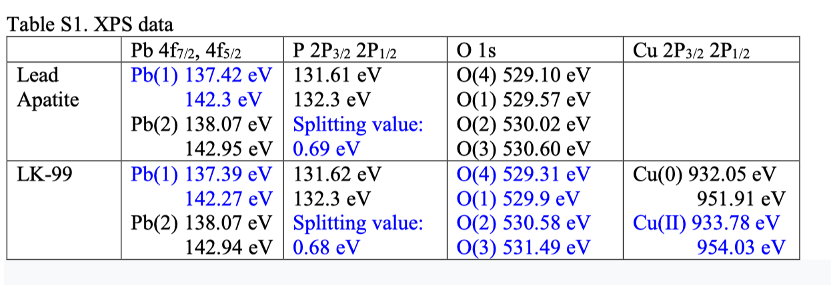
看看表S1,Pb(1)和Pb(2)之间Pb(1)的B.E.略有变化。 四个Pb(2)离子由磷灰石的网络结构组成,六个Pb(1)离子由正文中的圆柱组成。 四种不同类型的氧气与Pb(1)和Pb(2)结合,并形成像图S3一样的多面体结构。
Looking at the table S1, there is a little change in B.E. of Pb(1) among Pb(1) and Pb(2). The four Pb(2) ions is composed of the network structure of apatite, and six Pb(1) ions is composed of the cylindrical column in main text. And four different types of oxygen are bonded to Pb(1) and Pb(2) and made a polyhedral structure like a Figure S3.
